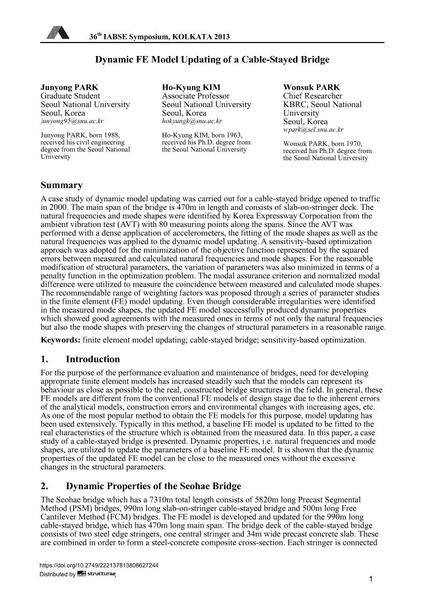Dynamic FE Model Updating of a Cable-Stayed Bridge

|
|
|||||||||||
Bibliografische Angaben
| Autor(en): |
JunYong Park
Ho-Kyung Kim Wonsuk Park |
||||
|---|---|---|---|---|---|
| Medium: | Tagungsbeitrag | ||||
| Sprache(n): | Englisch | ||||
| Tagung: | IABSE Symposium: Long Span Bridges and Roofs - Development, Design and Implementation, Kolkata, India, 24-27 September 2013 | ||||
| Veröffentlicht in: | IABSE Symposium Kolkata 2013 | ||||
|
|||||
| Seite(n): | 1-8 | ||||
| Anzahl der Seiten (im PDF): | 8 | ||||
| Jahr: | 2013 | ||||
| DOI: | 10.2749/222137813808627244 | ||||
| Abstrakt: |
A case study of dynamic model updating was carried out for a cable-stayed bridge opened to traffic in 2000. The main span of the bridge is 470m in length and consists of slab-on-stringer deck. The natural frequencies and mode shapes were identified by Korea Expressway Corporation from the ambient vibration test (AVT) with 80 measuring points along the spans. Since the AVT was performed with a dense application of accelerometers, the fitting of the mode shapes as well as the natural frequencies was applied to the dynamic model updating. A sensitivity-based optimization approach was adopted for the minimization of the objective function represented by the squared errors between measured and calculated natural frequencies and mode shapes. For the reasonable modification of structural parameters, the variation of parameters was also minimized in terms of a penalty function in the optimization problem. The modal assurance criterion and normalized modal difference were utilized to measure the coincidence between measured and calculated mode shapes. The recommendable range of weighting factors was proposed through a series of parameter studies in the finite element (FE) model updating. Even though considerable irregularities were identified in the measured mode shapes, the updated FE model successfully produced dynamic properties which showed good agreements with the measured ones in terms of not only the natural frequencies but also the mode shapes with preserving the changes of structural parameters in a reasonable range. |
||||
| Stichwörter: |
Schrägseilbrücke
|
||||
